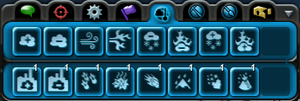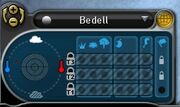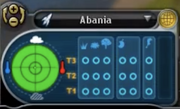
Set of all terraforming tools, except the Staff of Life.
Terraforming is the process of altering a planet's atmosphere, temperature, flora or creatures, which is available to the player in the Space Stage through many tools. A planet's habitability is given by its terrascore or T-score, which classifies it as either T0, T1, T2 or T3. The T-score and terraforming are important parts of the mechanics of the Space Stage, since they determine how many colonies planets can have and their complexity.
T0 planets are uninhabitable except to the Grox, and those from T1 onwards may harbor flora and regular creatures. Both allow for only one colony. Although T1 planets are common, increasing their T-scores to T2 and T3 is necessary to increase the number of possible colonies to two and three respectively, as well as putting more buildings, turrets and vehicles in them.
While player can also alter a planet's color and geography, these have no effects on habitability and are thus distinct from terraforming.
T-scores[]
Each planet has a T0, T1, T2, or T3 score. This affects how many cities the player can build, and how many forms of life can reside here. The T-score is also by a dot on a graph of concentric rings, which moves as the planet is terraformed. While terraforming, the dot's speed and direction are depicted with a series of up to three arrows. For example, the Heat Ray moves a dot to the right, whereas an Atmosphere Freezer moves it to the left-down corner. Stopping the use of a tool will not immediately stop the dot, and will continue its original direction for some time, making terraforming more challenging.
T0[]

A T0 planet.
Uninhabitable planets devoid of flora or fauna. Compared to inhabitable planets, T0 planets vary drastically in appearence due to their extreme differences in atmosphere and temperature. Although any T0 planet can be colonized, only one city is allowed and no buildings other than the city hall can be built. Cities cannot use vehicles either, so spice cannot be produced.
- Cities have atmospheric shields.
- Natural hazards, such as electric storms or fountains of lava.
- 1 city, cannot build beyond City Hall.
- The Grox can only survive on T0 planets and build up to 3 cities on one, with buildings, turrets, and vehicles similar to a regular species' T3 planet.
T1[]

The process of filling a T1 planet with flora and creatures.
T1 planets are the most common after T0 planets. At most, their ecosystems support one shrub, one small tree, one large tree, two herbivores and one predator (either a carnivore or omnivore). Many T1 planets only have flora and no creatures, being identified with a leaf icon in that case. Planets that have at least one herbivore are identified with a paw icon. T1 planets occasionally have Tribal Stage creatures and rarely have Civilization Stage creatures.
If the ecosystem is filled, T1 planets can only support one colony with five buildings and complete set of turrets and vehicles.
- 1 species of the small, medium, and large plant each.
- 2 species of herbivores.
- 1 carnivore or omnivore species.
- A balanced atmosphere.
- A reasonable temperature.
- 1 city, up to 5 buildings.
T2[]

The process of filling a T2 planet with flora and creatures.
T2 planets are far less common than T1 planets. They have a more limited range of atmosphere and temperature. At most, their ecosystems can support two shrubs, two small trees, two large trees, four herbivores and two predators. Naturally occurring T2 planets are never flora-only planets, only the player can make them. Tribal Stage creatures often inhabit T2 planets, but this is rarer for Civilization Stage and almost non-existent for empire homeworlds. However, upon colonization, empires will often terraform a planet into T2. The ruined planet is always a T2 planet, albeit with an incomplete ecosystem.
If the ecosystem is filled, T2 planets can support two colonies with a total of 11 buildings and complete set of turrets and vehicles.
- 2 species of each size of the plant.
- 4 species of herbivores.
- 2 species of carnivores/omnivores.
- A very nice temperature.
- A well-balanced atmosphere.
- 2 cities, able to fill all build sites on each city, or all the turrets, or a smaller mix of anything in between.
T3[]

The process of filling a T3 planet with flora and creatures.
T3 planets are the rarest kind of habitable planet. They have a very limited range of atmosphere and temperature. At most, their ecosystem can support three shrubs, three small trees, three large trees, six herbivores and three predators. In fact, wild T3 planets are almost non-existent, except for Storybook planets. The player's homeworld is always a T3 planet, as are nearly all homeworlds for other empires. Civilization Stage planets are commonly T3 as well, which occurs to a lesser extent for Tribal Stage planets.
If the ecosystem is filled, non-homeworld T3 planets can support three colonies with a total of 27 buildings and complete set of turrets and vehicles. However, homeworlds can have anywhere from 4 to 10 colonies, which the player can acquire by conquest or trade of naturally-occurring empires or those that they have created themselves using the monolith. In the case of trade, homeworlds will be sold by no less than 10 million sporebucks. The player's homeworld is always T3, as well as the original homeworlds of other non-Grox empires, and as an exception they may have up to 10 cities. The player's homeworld as well as those of initiated saved games are the only ones that cannot be terraformed or sculpted, although it is possible to change their color and use the Species Eradicator to eliminate creatures and subsequently introduce new ones.
- 3 species of each size of the plant.
- 6 species of herbivores.
- 3 species of carnivores/omnivores.
- Perfect atmosphere density.
- Perfect temperature.
- 3 cities (or up to 10 in the case of a home planet), with full building capabilities, including the ability to fill all build sites and turrets.
Prior inhabitation[]

Terrascore map on a homeworld.
T1 to T3 planets are often already inhabited (but not necessarily with a complete ecosystem). If a sentient lifeform inhabits any planet in a system, then no planets in that system can be colonized by a different species.
Any creature at or above Tribal Stage blocks colonization of a system. Destroying every city or village of a planet in the Tribal or Civilization Stage will allow to colonize, but every single city must be destroyed, which is time-consuming in the Tribal stage where many villages dot the map, making the Gravitation Wave Superpower very useful. It is possible to deterraform a planet to T0 and then reterraform it, but this takes significantly more money or energy than just destroying cities. When deterraform a planet with cities in the Civilization Stage, the cities cannot survive without a shield.
Empires will fight back if they are attacked as usual, and cities in the Civilization Stage can fire at the player with their turrets (if they have them) and do some damage.
Changing the T-score[]
The T-score of a planet is determined only by its atmosphere and temperature.
Exceptions[]
The player can use different tools to create ecosystems that would not occur otherwise in the game or that cannot be achieved with terraforming tools alone.
The Wildlife Sanctuary allows a player to stably place up to 30 creatures on a planet regardless of its T-score. It also does not place any restrictions on the creatures' diets. Destroying the Wildlife Sanctuary will however cause most species, including flora and creatures, to go extinct.
The Species Eradicator allows the player to create empty slots, such as food chains that have only flora and a predator without herbivores. This is not possible with conventional terraforming, as the slot for predators in a food chain cannot be unlocked unless the flora and herbivore slots are filled first. However, although the species eradicator is useful to replace creatures quickly, it is not recommended to just leave them empty, as it will cause the ecosystem to collapse. In addition, the Species Eradicator is the only way that the player can terraform their homeworld, as Terraforming Tools cannot be used.
It is possible to terraform a planet from T0 to up to T3 without putting any creatures in it. In such situation, all the T-score rings appear yellow-colored. Such planets can only be made by the player and will not generate in the game. However, it is not advisable as filling planets with life is necessary to stabilize their T-scores.
Motivations[]
There are the uses/motivations of using the terraforming tools:
Spice[]
Terraforming will also affect the capacity of spice produced by planets. Placing efficient cities will boost the production of the spice from the planet. Note that one can purchase single-use tools that can be placed on a planet to reduce the occurrence of biological disasters, as well as to protect abducted species. See Wildlife Sanctuary.
Relation bonus[]
Terraforming a planet where the empire creature already is living will give the player a Relation bonus with the notable exception that the Grox consider this an act of war, as they can only live on T0 planets. This bonus can be positive or negative, depending on whether the T-score is being improved or degraded. The exact figure is dependent on the empire's archetype. Ecologists, for example, are more affected by terraforming than other empires.
As a weapon[]
The multi-use tools such as the heat ray can be effective weapons against enemy homeworlds. Without the concern about capturing the planet, simply flying around and avoiding fire whilst aiming the heat ray (or any other multiuse tool) at the planet will quickly lower the T-score to 0 and thus eliminate all but one of the settlements, allowing for an easy victory. It is far less costly than a planet buster and comes with none of the relationship consequences. When the planet is deterraformed, the message will pop up to say "Something has died out" in the message box. This process can be also done to rid of tribes and civilizations in order to conquer more planets, meanwhile using this on an empire's colonized planet will decrease relationships.
Tools[]
There are two main kinds of tools, depending on whether they use the ship's energy or consumable charges. Energy-based tools are bought only once and can be used indefinitely provided that the ship has energy. Consumable tools have limited, expendable charges and do not use the ship's energy. All consumable tools can be bought again, except the Staff of Life, which is given by Steve is limited to only 42 charges. Some of the following tools also alter the planet's terrain, such as the volcano, and could also be considered a form of planet sculpting tool.
Energy-based[]
- Refrigeration Ray: Lowers planet temperature.
- Cloud Accumulator: Raises atmosphere level.
- Cloud Vacuum: Lowers atmosphere level.
- Heat Ray: Raises planet temperature.
- Hot Cloud Vacuum: Raises the planet temperature and lowers the atmosphere level.
- Cold Cloud Vacuum: Lowers the planet temperature and the atmosphere level.
- Hot Cloud Seeder: Raises the planet's temperature and the atmosphere level.
- Air Conditioning: Lowers the planet's temperature and raises the atmosphere level.
Consumable and rebuyable[]
- Atmosphere Generator: Raises atmosphere level upon being placed.
- Ice Storm: Lowers planet temperature upon use.
- Meteor Shower: Raises planet temperature upon use.
- Drought Generator: Lowers atmosphere level upon being placed.
- Asteroid Call Button: Raises the planet temperature and lowers the atmosphere level upon use.
- Atmosphere Freezer: Lowers the planet temperature and atmosphere level upon use.
- Volcano: Raises the planet temperature and atmosphere level upon use.
- Ice Comet: Lowers the planet temperature and raises the atmosphere level upon use.
Consumable and non-buyable[]
- Staff of Life: Instantly turns any planet into a T3 planet with a filled ecosystem. However, it is limited to 42 uses and is not easy to obtain.
Obtaining tools[]
The quickest way to obtain all terraforming tools is to collect the Empire 5 badge. However, the player can also collect the Missionista 4 badge to earn access to all ammunition-based tools. The energy-based tools can then be obtained by earning the Terra-Wrangler 5 badge.
Trivia[]
- There is a prototyped set of tools designed to create planets and similar objects that did not make it into the final game. For more information, see Galactic Editor. The Spore Galactic Adventures expansion pack includes a planet creator with the Adventure Creator, to edit the terrain where the adventure will take place. However, there is no planet creation for normal planets nor a planetary editor.
- The player can deterraform an unused saved game planet, but it will disappear from the menu.
- To make terraforming easier, it is possible to lock the T-score dot in place by quitting to the main menu and reentering.
External links[]
- YouTube - Terraforming video guide — A comprehensive video on how to terraform.
- IGN - Spore Walkthrough — One of the most complete guides on the internet.



